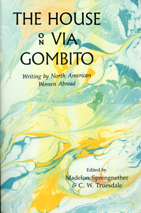In Ferrara, Italy, not far from the Adriatic Coast, my friend traveling with me recounts the eel festival in Commachio. In Ferrara, the streets are paved with small stones worn smooth by the huge Po River which brings agricultural wealth to the middle of northern Italy. The stones, called ciottoli, make walking rather hard, but they give an antique appearance even to the streets of Ferrara. Ferrara founded in the middle ages and enhanced by the d’Este family in the Renaissance wears a lovely brick warmth; even its cathedral tower is covered in warm pink and white marble. It is a quiet old city because motorized traffic is prohibited. Everyone rides a bicycle or walks. And the bicycles are adorned with woven or wicker backets, bells, soft seats, and leather covers over their wheels, which I puzzle out and decide help to keep the tires from getting wet. But even as I write this, I realize it’s probably not correct.
In the Archaeological Museum, we wander through rooms of vases and amphora, plates and other serving dishes dug out of preChristian tombs in the Po Delta. I’m particularly taken with the flat fish dishes adorned with various kinds of fish, especially cuttlefish, a kind of octopus; flat flounder-type fish and many other kinds whose names are given in modern Italian. Generally, signage in Italian museums leaves much to be desired: there is a lot of arcane information, but almost nothing that makes sense to the casual observer. True in this case except for the fish bowls, wonderfully explicated; for the tombs themselves which are represented by skeletons drawn in fake sand with the amphora and dishes presented in the same positions as originally found. And for the amber necklaces which the placard tells us came originally from the Baltic.
I love best the two piroques which were first unearthed from the Po Delta in the 1920s or 30s, but almost immediately recovered with muck, then fully excavated in 1946. For two years archaeologists worked to preserve them–difficult to do with wood which would normally disintegrate if left to the air. Now these long log boats, from the 2nd or 3rd century after Christ, are housed in their own dimly lit room. As I study the placards I think I hear the cack-hoot of a heron; then the cries of gulls. Actually I am hearing these bird calls because just beyond the piroques is showing a slide-show accompanied by sounds of the Po Delta. In this watery world, the piroques would ride easily across the shallow water; flamingos still step their strange backward-jointed legs–they’re not pink like the ones we see in Florida but mostly white since the shrimp that contain the agent that colors their feathers isn’t always available in the Po Delta.
This dreamy flowing water, dotted with strips of land, makes me feel enchanted. “The next time you come to Italy,” friends here insist, “you must go to Venice. From there it is easy to take a tour into the Po Delta.” I know, it’s time I visited Venice, but even more, I am drawn to this watery world, more water than land, flowing quietly and insistently into the ancient seas across which very early Italians ordered vases from Greece, glass from the Phoenicians in Sicily or North Africa, and amber like clotted gold from the frigid Baltic.


Leave a Reply